AMD Kaveri Review: A8-7600 and A10-7850K Tested
by Ian Cutress & Rahul Garg on January 14, 2014 8:00 AM ESTDrawing Performance Conclusions
As I progressed through the testing for this review, I became aware of trends in two things: absolute performance, in terms of numbers, and generational improvements across platforms. With AMD moving the Bulldozer based architectures from Piledriver in Trinity and Richland to Steamroller in Kaveri, the base CPU design has had a relatively long run in order to be optimized to the limitations on the CPU side. Obviously AMD has also had a chance to change the lithography node in there as well, and as such has optimized for design rather than performance. This matters a great deal when we look at the power banding (45W, 65W, 95W) and performance in each segment.
In order to display just how much Kaveri has grown in relation to the previous generations, I processed our mountain of data to show graphs where percentage gain against the older generations really does matter. As mentioned previously in this review, it all depends on whether the software can take advantage of the new features afforded by the architecture. In this review we have spent a lot of time discussing advantages for Kaveri in terms of compute (HSA, hUMA, hQ) and gaming (Mantle, TrueAudio), but some of these are still a little way off for software integration. So what does that translate to if you are looking for an APU today – does Kaveri still expand its wings with the integration of the GCN architecture, or does it lag behind due to the lithography node no longer being optimized for frequency. The proof is in the results.
IGP Gaming, 1280x1024
For the 100W APUs at 1280x1024, there is almost no movement between the Richland and the Kaveri APUs, except for Company of Heroes which would seem to leverage the extra SPs more than the MHz available.
45W APUs are clearly in vogue at 1280x1024, each of them providing a good bump over Richland.
IGP Gaming, 1680x1050
1680x1050 sees more benefit for the 100W APUs, but the 45W APUs still show big leaps.
IGP Gaming, 1920x1080
At 1080p the effects are more pronounced all around.
CPU Timed Benchmarks
Unfortunately the CPU timed benchmarks at 100W are bit over the place. Here we are dealing with an IPC gain but MHz deficit, and each benchmark has a different way of dealing with it. For Agisoft, MHz wins, but for Xilisoft, the Kaveri improvements work out well for the system.
At 45W the situation is a lot more clearer, and the newer APUs have the advantage, especially in Adobe After Effects.
CPU Score Benchmarks
45W still makes the biggest jump when it comes to score based CPU benchmarks.
IGP Synthetics
I never like putting much thought into the synthetic results – here both the 100W and the 45W range are showing good improvements all around. 3DMark 06 has the most trouble getting improvements as it relies more on the grunt, rather than the features that Kaveri affords.
IGP Compute
Off the bat we can see just how much of a difference the Kaveri GPU Compute can make over previous APUs. This is still without hUMA fully being in effect while we wait for a proper driver and software stack to become available.
Up to a +222% boost from Kaveri is amazing for a 45W part.
AMD vs Intel
For a little tete-a-tete, putting the 65W Iris Pro up against the 65W Kaveri seems like a good idea. To add to the mix, due to the extreme price difference of Iris Pro in this equation, we also add the 95 W Kaveri for comparison.
It is interesting to note that at the lower resolutions the Iris Pro wins on most benchmarks, but when the resolution and complexity is turned up, especially in Sleeping Dogs, the Kaveri APUs are in the lead.


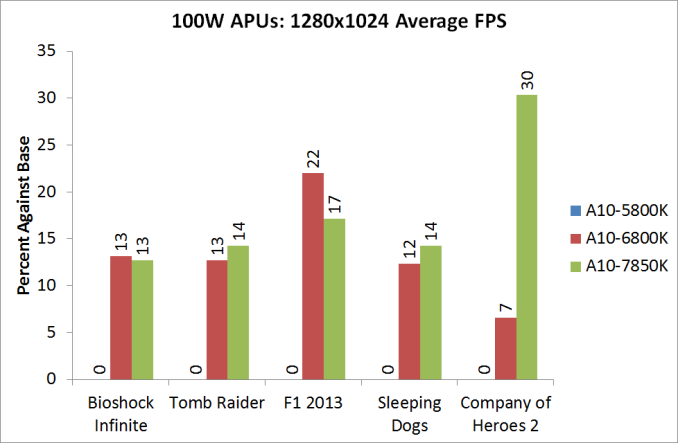
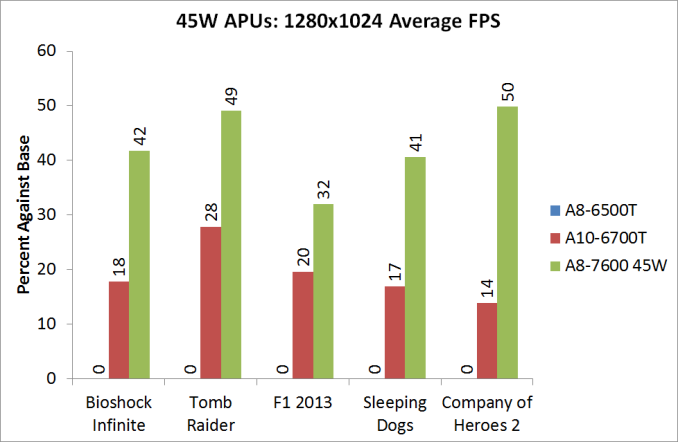
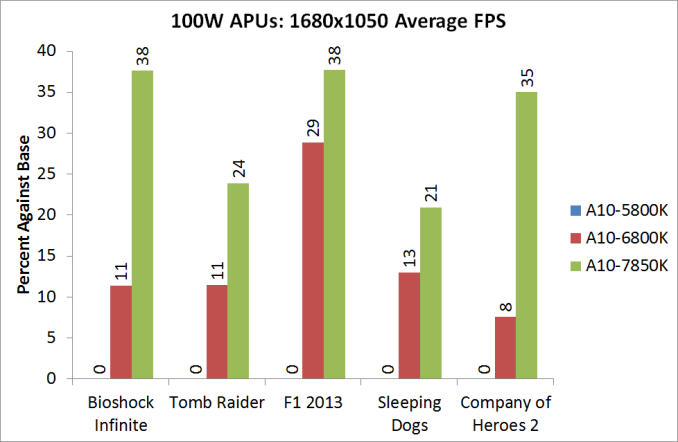
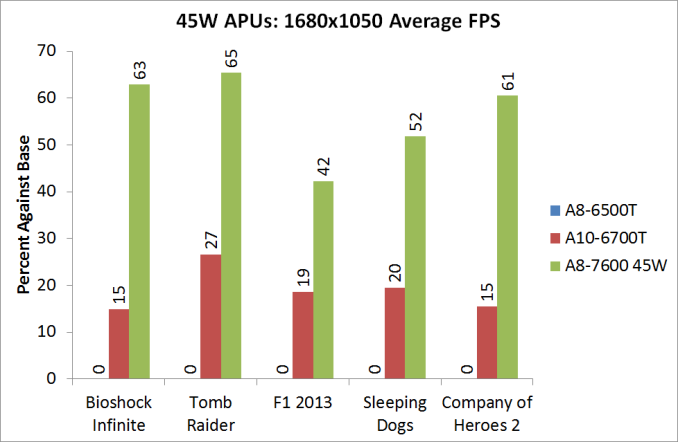
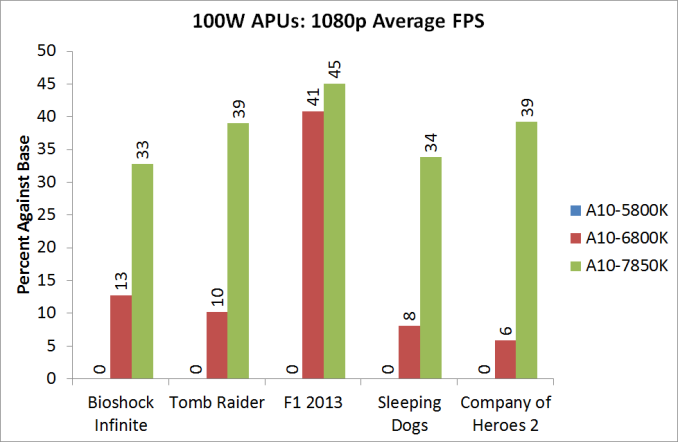

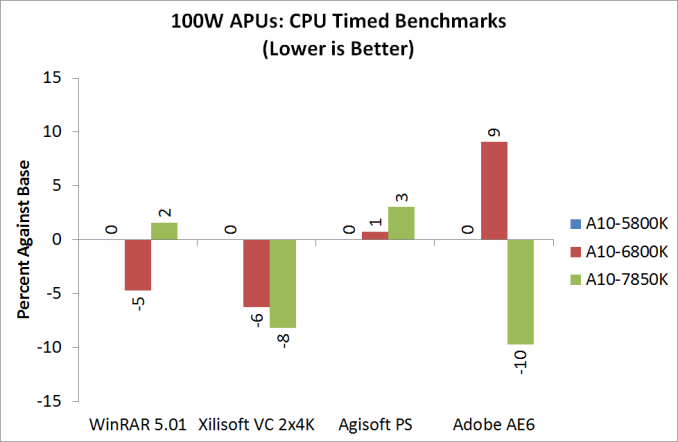
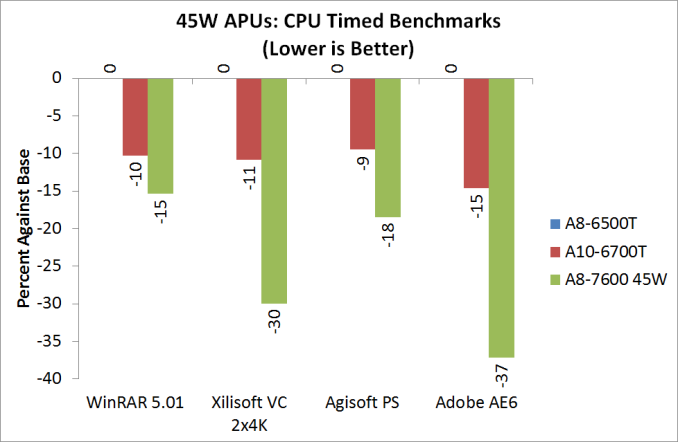

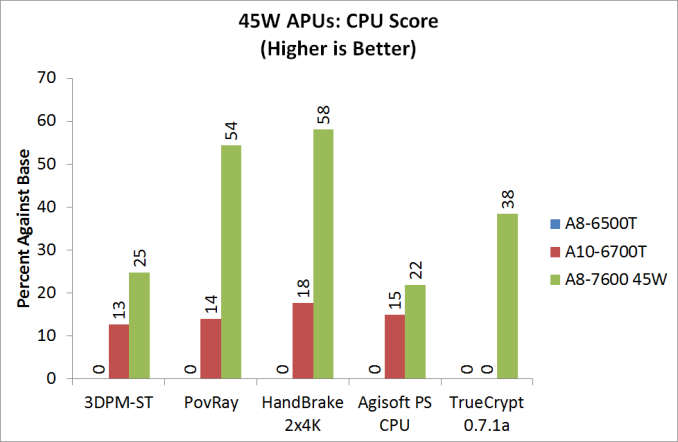
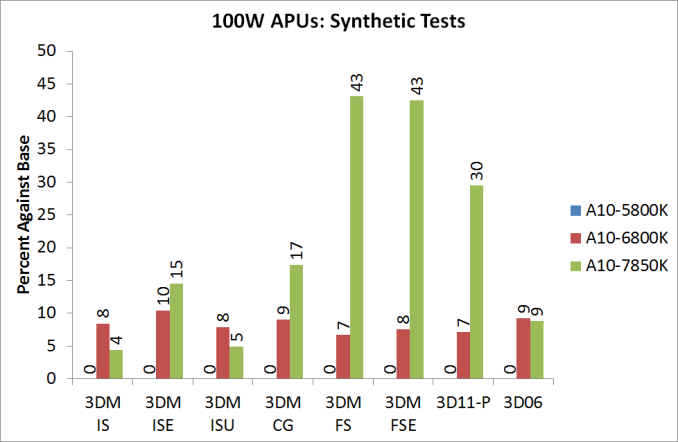
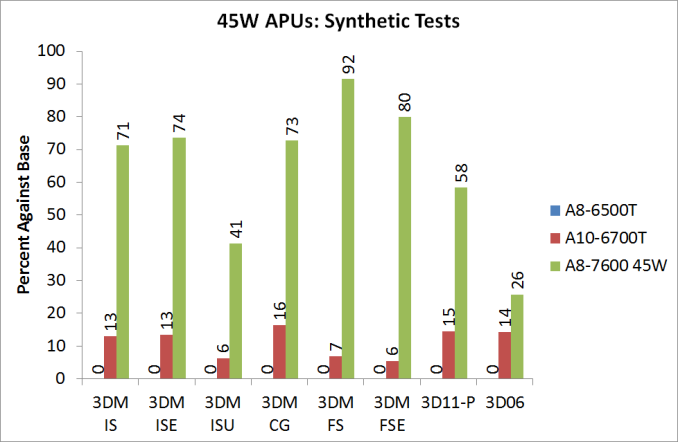
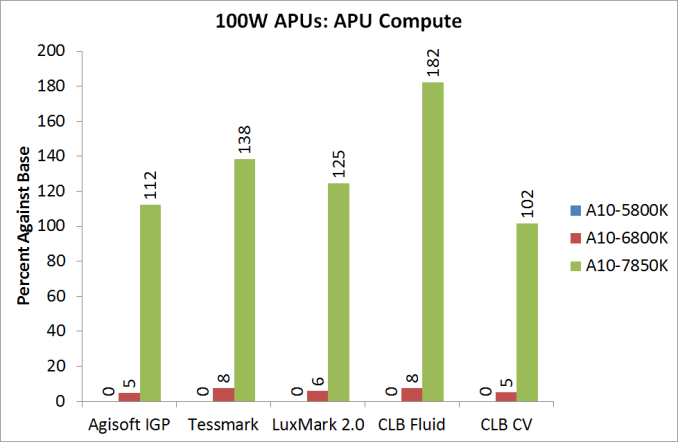

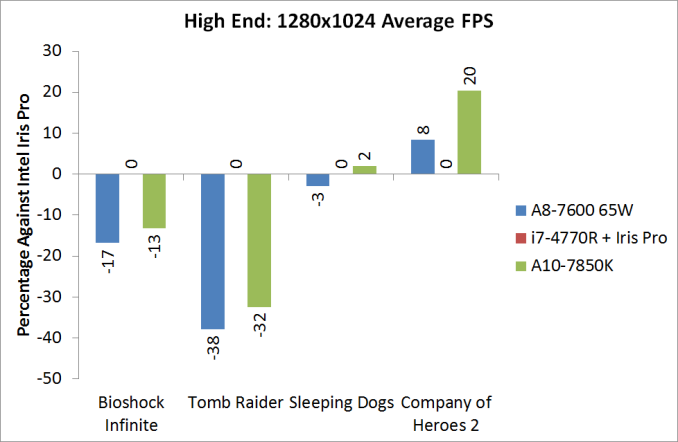
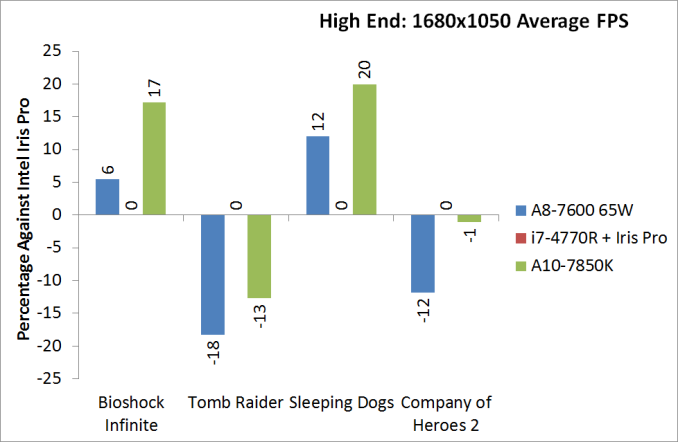
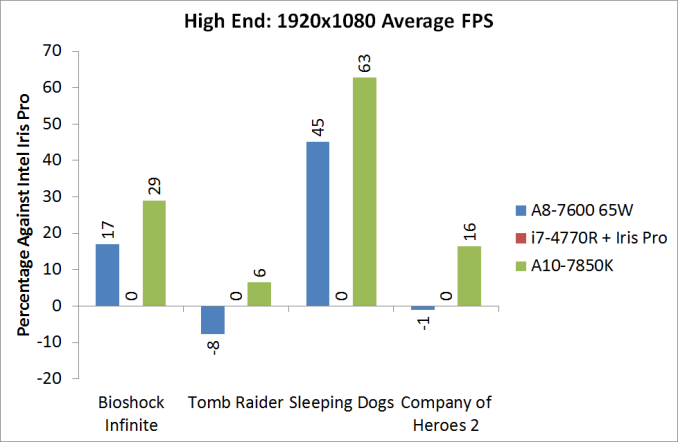








380 Comments
View All Comments
extremesheep49 - Friday, February 21, 2014 - link
I don't know if anyone will even see this now but..."The reality is quite clear by now: AMD isn't going to solve its CPU performance issues with anything from the Bulldozer family. What we need is a replacement architecture, one that I suspect we'll get after Excavator concludes the line in 2015."
I don't know that this conclusion is very fair considering this statement if you compare it to a previous article linked below. The linked article recommends a (currently) $100 100W A8-5600K. The Kaveri equivalent is a $120 45W CPU of approximately the same performance.
Doesn't the linked article's recommendations contradict your Kaveri conclusion at least for some cases? Kaveri's CPU performance probably is sufficient for many discrete GPU setups.
http://anandtech.com/show/6934/choosing-a-gaming-c...
Quote from link:
"Recommendations for the Games Tested at 1440p/Max Settings
A CPU for Single GPU Gaming: A8-5600K + Core Parking updates"
Novaguy - Sunday, February 23, 2014 - link
Gaming performance is usually (but not always) GPU bottlenecked, not CPU bottlenecked.The reason why a trinity was getting recommended in a lot of gaming boxes was that in dollar limited scenarios, you'll often get better gaming performance mating a $120 quad core trinity with a $300 gpu, versus a $220 i5 with a $200 gpu.
For even better results, mate an $80 Athlon II X4 750K if you're going discrete gpu, but I don't think the gpu-less trinity chip was available then.
PG - Monday, February 24, 2014 - link
I wanted to compare Kaveri to some other cpus not in this review. Bench would be perfect for that, but the Kaveri cpus are not listed there. Why? Can they be be added?Cptn_Slo - Tuesday, April 1, 2014 - link
Well at least this shows that AMD is able to increase performance significantly given the appropriate die shrink. I'm a big Intel fan but a healthy company/market needs competition, and looks like AMD is able to offer that in at least some areas.zobisch - Wednesday, April 2, 2014 - link
I have an h60 cooler on my 7850k with 2400mhz ram OC'd to 4.4ghz and I love it... I think the corner for APU's will really turn when DDR4 boards come out. I also would like to see an 8core, 24 compute gpu as well but that's probably a die shrink or more away.vickfan104 - Tuesday, May 6, 2014 - link
An Xbox One/PS4-like APU is what I'm still looking for from AMD. To me, that seems like the point where an APU becomes truly compelling as opposed to CPU + discreet GPU.P39Airacobra - Thursday, January 1, 2015 - link
I still can't understand why anyone would be insane enough to pay the outrages high price for a AMD APU simply because it has a built in GPU that can play some games! When for the same price you can get a high end i5 CPU and mid range GPU for a few dollars more! Or for the exact same price you can get a AMD quad and a mid range GPU. Either choice would bloaw any AMD APU out of the water! Yes you can crossfire the APU, But you can also crossfire and SLI regular GPU's. Besides by the time you paid the money for a AMD APU and a GPU to crossfire with it you could have got a nice i3 or FX 6300 or even a last gen IVY i5 with a GPU like a R9 270 or a GTX 660. And either one of those would blow away a APU/Crossfire setup! What are you people thinking? I swear people today would not only buy the Brooklyn bridge once but more than once!P39Airacobra - Thursday, January 1, 2015 - link
Most logical thing to do is buy FX-6300 for $119 and a Motherboard for $60 and then buy a GTX 660 or a R9 270 and buy a 1600x900 resolution monitor and then you will be able to max out anything.P39Airacobra - Thursday, January 1, 2015 - link
Besides 60fps on Medium/High at only 1280x1024 is a laugh! A GT 740 and a R7 250 can do better than that!kzac - Monday, February 16, 2015 - link
After living with the processor on a gigabyte main board for the past several months, I can honestly say its bested both the core i3 and i5 systems (some quad core) I have used in the past. What it might not score on benchmarks for all out throughput it makes up for in its multitasking capability. What normally crashes my i3 and makes my i5 struggle while multitasking (many things open and operating at the same time), doesn’t tend to effect the A10 APU. The core i3 i am using is the later 3220 chip which completely chokes with anything above average multitasking under W7pro, even though it has 12 gig of 1600 ram. The core i5 was better at multitasking than the core i3 but still not near as effective at multitasking as the AMD A10 7850. Where I cannot speak to the performance of the AMD A10 for gaming, for multitasking is very effective.For gaming I have used the FX series AMD processors, both Quad Core and 8 core.